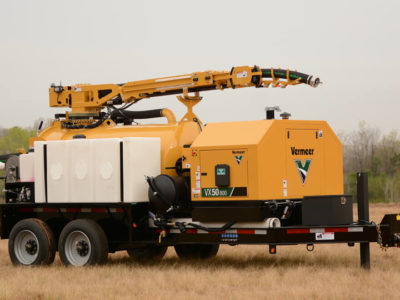On a horizontal directional drill (HDD) site, selecting the right vacuum excavator for the jobsite can affect your crew’s productivity. They offer invaluable ways to help keep your jobsite maintained and helping to avoid damage to existing utilities by offering visual verification of utility placement.
There’s no one-size-fits-all solution for every excavation job, but a variety of options exist for the utility excavation market. Take a look at some things to consider before selecting the ideal model for your project and best practices for your vacuum excavator.
Selecting a vacuum excavator
When selecting a vacuum excavator, the first things to consider are the ground conditions and jobsite requirements. This will help you select the right spoil tank size, horsepower and trailering option.
Keep in mind the capacity of your project. Large, ongoing projects need a versatile vacuum with additional spoil tank and freshwater capacity. Spoil tank sizes range from 100 gallons to 1,200 gallons (378 L to 4,542.5 L) for trailer vacuums and 800 gallons to 6,059.2 gallons (3,028.3 L to 22936.6 L) in the truck market.
Consider the versatility of the vacuum excavator. Small jobsites demand less power, equipment and labor while large projects require heavy-duty equipment. For harder-to-reach jobsites in uneven terrain, it’s necessary to consider heavy-duty trailer options.
Before starting the job
Before starting a project, call 811 or a similar locating service. Not only is it a best practice in the industry, but it’s also required by law in many states and global regions.
When on the phone with the national 811 hotline, give the operator details of your intent and job location and they will route your request to a local call center. Utility companies will then be alerted of your plans and will send an employee to the proposed site to mark utility lines.
When at the jobsite, carefully inspect for evidence of local or unmarked utilities. Also look for evidence of previous excavations such as utility risers, disturbed soil and repaired pavement and ask the property owner if there are any unmarked utilities. Also, use a utility-locating equipment, like the Vermeer Verifier® G3 utility locator, to confirm what the utility company locates, help to identify unmarked utilities and determine approximate depth of lines.
Before digging begins, everyone should understand the project plan, equipment involved and expected roles on the jobsite. Be sure to implement an action plan, including local emergency service phone numbers.
Finally, use the vacuum excavator to soft-dig or pothole and visually verify the location of underground lines. Many jurisdictions and safety regulations have specific requirements for exposing utilities in the area of excavation.
For more information on the vacuum excavator models available, contact your local Vermeer dealer.
Always refer to the product’s operator’s and/or maintenance manual for safety messages and further instructions.
Vermeer MV Solutions, Inc. reserves the right to make changes in engineering, design and specifications; add improvements; or discontinue manufacturing at any time without notice or obligation. Equipment shown is for illustrative purposes only and may display optional accessories or components specific to their global region. Please contact your local Vermeer dealer for more information on machine specifications.
Vermeer, the Vermeer logo and Verifier are trademarks of Vermeer Manufacturing Company in the U.S. and/or other countries. © 2022 Vermeer Corporation. All Rights Reserved.
